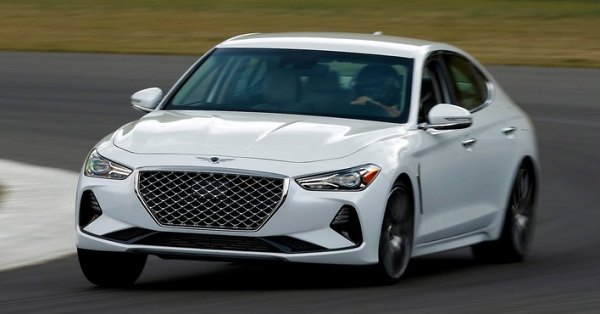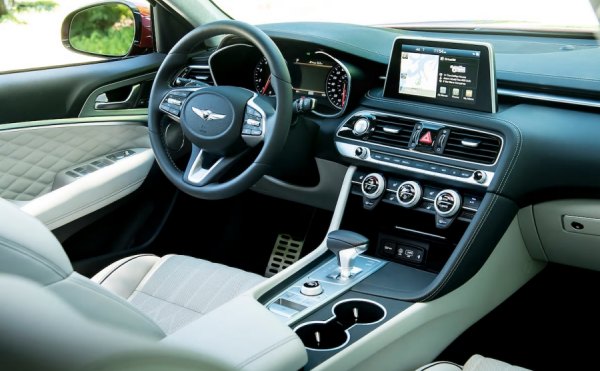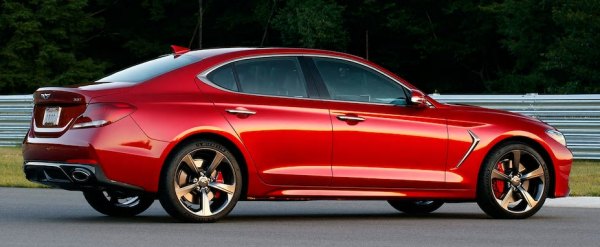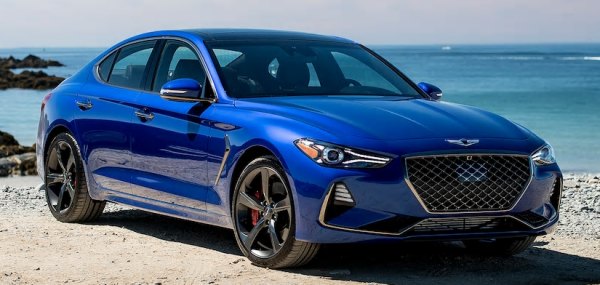Published
on 2
Sep 2018
|
All rights reserved.
|
|
|

|
|
G70
is the sister car of Kia Stinger, but it aims to the heartland of
European compact premium cars.
|
|
In the beginning, there
was only one compact premium car sold for sporty driving experience:
BMW 3-Series. Then it was joined with Audi and Mercedes. Jaguar and
Cadillac took a giant leap in recent years, while Lexus took a similar
route with the introduction of F-Sport line. Suddenly, every premium
brand wants to be sporty. The Korean is no exception. While in search
for a place in the premium marketplace, they push hard towards the
sporty side at the same time. Last year, Kia Stinger GT surprised us
with its strong dynamics and attractive styling. However, to some
extent it still fails to deviate from the traditional formula of Korean
cars, i.e. more space, more metal and more car for less money. If you
want to win the admiration of Western critics, you need to do it fair
and square, aim straight at the heartland of its competitors. Hyundai’s
Genesis G70 is that car.
It goes without saying the Genesis G70 is the sister car of Kia
Stinger. Both ride on the same rear-wheel-drive platform, sharing the
same engines, suspensions and all critical components. However, the
Hyundai is a conventional saloon while the Kia is a hatchback – that’s
why Kia calls it 4-door coupe – and most importantly, the G70 is more
compact. Its 2835mm wheelbase is 70mm shorter than the Stinger. From
nose to tail it is 145mm shorter, from side to side 20mm narrower. This
means it is only marginally larger than the current 3-Series, a gap
likely to disappear when the next generation 3-Series arrive this fall.
With the addition of G70 to the existing G80 and G90, the Genesis brand
now completes the trio of 3, 5 and 7-Series fighters.

|
|
Luc
Donckerwolke plus Peter Schreyer guarantees a handsome design.
|
|
Design is very important to this class. Genesis is benefited by the
arrival of ex-Lamborghini Murcielago designer Luc Donckerwolke to be
its design chief, overseen by Peter Schreyer at group level. While
there is no resemblance to Lambo at all (fortunately), the G70 is a
handsome design in its own right. Its big mesh grille is toned down a
bit so that not to divide opinions as much as G80. The proportion is
sporty and sleek, the details are stylish and finishing is of high
level. If you have to be picky, you may say it has a shade of Infiniti
Q50 and Alfa Romeo Giulia. I just hope it could be more characterful,
not just relying on a bold front grille to distinguish from others. Its
Kia sister is more successful in this respect.
Inside, the positive impression continues. Its dashboard design focuses
on the driver. Instrument clusters and center console are stylish
enough. Controls and buttons are well laid out and easy to use.
Stitched leather upholstery and real aluminum accents feel premium. The
build quality is on a par with BMW, if not Audi or Mercedes, but it is
significantly higher than its Kia sister. What a pity it shares the
same cheap infotainment system with Stinger. The 8-inch touchscreen is
not only small but its graphics are unappealing. The software and
response are far from premium level either. Like most in this class,
the cabin is not spacious, but it feels intimate and enveloping on the
driver seat. The rear seat is tighter than that of the 3-Series,
especially headroom.

|
|
Driver-focused
design mates with high-quality materials.
|
|
Predictably, the G70 is lighter than Stinger, by about 50 to 70kg.
However, it is still a lot heavier than its European rivals. For
example, the 4-cylinder base model carries 130kg and 170kg more than
the comparable 3-Series and Giulia, respectively. Even a Quattro and
DCT-equipped A4 is 90kg lighter than the leanest rear-drive,
manual-gearbox G70. This is because the Hyundai’s chassis is all-steel,
although hot-stamped ultra-high-strength steel are used, whereas its
rivals employ chassis comprising of steel and aluminum. The heavier car
needs more powerful engines to propel, as we shall see, and this will
inevitably reflect on fuel economy. The chassis rides on MacPherson
struts suspension up front and multi-link axle at the rear, supported
with optional adaptive dampers. The electrical power steering has a
variable-ratio rack.
All these sound quite conventional, but the most important is, this car
was tested extensively in Nurburgring under the guidance of Albert
Biermann, the former BMW M division boss whose most recent achievement
is the fabulous handling of i30N, Veloster N and, you are right, Kia
Stinger. This is a big
advantage and could be a threat to BMW, because Biermann knows what
made BMW drove so good in the past. I suspect his arrival led to the
decision to offer a Dynamic package which includes stiffer springs,
high-performance Michelin Pilot Sport 4S tires and Brembo front brakes.
And most likely the two diagonal strut tower braces that reinforce the
engine compartment. To win over the established European rivals,
Hyundai is willing to invest.

|
|
Albert Biermann
adds the final touch to the otherwise conventional chassis.
|
|
As said, the more car needs the more engine. The top G70, as every
review in the launch focuses on, is powered by the 3.3-liter twin-turbo
GDI V6 also found in Stinger. It produces a class-leading 370
horsepower and 376 pound-foot of torque across a wide band. Even though
Hyundai’s own 8-speed automatic transmission is not as responsive as
its ZF counterpart, this G70 is quick. It is good for
0-60mph in only 4.5 seconds, and top speed is 168mph. For comparison, a
BMW 340i quotes 4.9 seconds and tops a regulated 155mph, although we
usually find it feels brisker in the real world.
Fitted with a standard LSD, the 3.3T model is also very capable in
corners. Its 4S tires offer bags of grip. Its suspension feels firm,
keeps roll in check yet deflects the worst bumps. The steering is heavy
and precise, though not as communicative as Jaguar’s. The brakes and
throttle respond positively. In most areas the Hyundai drives as good
as a BMW or Audi, if not Jaguar XE. Maybe not as agile as its rivals
due to its extra weight, but it feels sporty and confidence inspiring.
All things are well put together to please a keen driver. It is also
refined when cruising on highway, although the 4S rubbers produce a lot
of tire roar. The only noticeable flaw is the stability control, whose
intervention is a bit abrupt, damaging the otherwise fluid handling.
 |
|
It drives as
good as a BMW or Audi...
|
|
However, the majority of buyers are likely to get the cheaper 2.0 Turbo
engine. On paper, with up to 255hp and 260 lbft of torque, it looks as
strong as its rivals. Nevertheless, in the real world it is not up to
the highest
level. Low-down response is slower than the four-cylinder motors of BMW
or Audi, and the noise it produces at the top end is uninspiring.
Taking the heavier car into account, it feels slower than a 330i or A4
2.0TFSI. On the plus side, this engine can be mated with a 6-speed
manual whose gearshift is light and positive.
Overall, the Genesis G70 is a remarkable effort, especially considering
it is the first attempt. While it does not break any new grounds, it
feels high-quality, stylish and sporty enough to lure buyers from the
German big three. A better four-cylinder engine, faster automatic
gearbox, more weight saving, better tuned stability control and a
roomier rear seat are what it needs to beat it rivals, but even without
them it
is still a well rounded product. It took Lexus and Infiniti a couple of
decades to feel a worthy rival to the European premium brands, while
Acura is still searching for the right path after 30 years. Hyundai
group is much smarter. Now it has two strong entries into the compact
premium car segment.
|
Verdict:     |
|